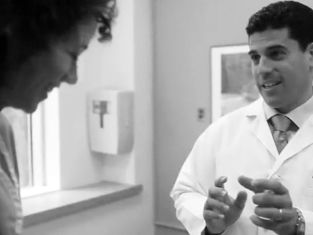Breast Reconstruction FAQs
 After a mastectomy or injury, many women are faced with the difficult decision of whether to proceed with breast reconstruction. To help patients better understand candidacy, recovery, and more, Dr. Oren Lerman can discuss the most common breast reconstruction FAQs (frequently asked questions) with patients at his Manhattan, New York, office. To schedule your consultation and learn more about breast reconstruction, contact us today.
After a mastectomy or injury, many women are faced with the difficult decision of whether to proceed with breast reconstruction. To help patients better understand candidacy, recovery, and more, Dr. Oren Lerman can discuss the most common breast reconstruction FAQs (frequently asked questions) with patients at his Manhattan, New York, office. To schedule your consultation and learn more about breast reconstruction, contact us today.
What Are My Treatment Options?
Although their are many different types of breast reconstruction options, the two basic categories of breast reconstruction to choose from are breast implants or natural (autologous) tissue. Some patients choose autologous breast reconstruction, which produces a more natural looking and long lasting result and utilizes tissue transferred from another area of the body. Other patients choose breast implants which tend to be a shorter surgery without the need for a scar on a different part of the body. There are pros and cons to each type of surgery and not all patients are good candidates for both.
What Is Flap Surgery or Autologous Breast Reconstruction?
Flap surgery is a breast reconstruction technique that uses a woman's own living tissue to recreate the breast mound instead of a breast implant. Tissue for flap reconstruction is transferred from another part of the body and may be taken from the:
- Abdomen - *most common location for Autologous breast reconstruction, the most advanced procedure when taking tissue from the abdomen is the DIEP flap (deep inferior epigastric artery perforator). Older variants of this procedure include the TRAM flap (transverse rectus abdominis myocutaneous) where the muscle is cut.
- Buttocks - gluteal artery perforator (GAP) flap - can be an SGAP flap located higher on the buttocks or an IGAP flap lower down
- Posterior thigh - profunda artery perforator (PAP) flap is one of the most recent additions to the types of flaps used in breast reconstruction. Dr. Lerman is one of the few surgeons in the country offering this type of surgery.
- Inner thigh - transverse upper gracilis (TUG) flap or the diagonal upper gracilis (DUG) flap
- Back - thoracodorsal artery perforator (TAP) flap is a variant on the Latissimus muscle flap used for partial breast reconstruction.
While other surgeons are limited to performing the older TRAM flap reconstruction technique which cuts the abdominal muscles, Dr. Lerman offers his patients microvascular breast reconstruction with perforator flaps such as the DIEP flap that preserve the muscle. This advanced method maximizes blood flow to the tissue flap, while also preserving the muscle of the abdominal wall. As a result, patients experience a lower risk of abdominal weakness, bulge or hernia.
What Is Microvascular Surgery?
Using a microscope, specialized instruments, and tiny needles, a fellowship trained microvascular surgeon reconnects small blood vessels, and nerves to transplant tissue from one part of the body to another. Just like transplanting a kidney or other organ from one person to another, the 'flap' of tissue is transplanted. The difference is that this tissue is coming from your own body and therefore cannot be rejected. Of course in order for the tissue or 'flap' to survive, the circulation must be restored by reconnecting the blood vessels. Microvascular surgeons perform free flap breast reconstruction to recreate the breast using natural tissue flaps giving the most natural looking, feeling and long lasting results.
What Is Nipple-sparing Mastectomy?
During a nipple-sparing mastectomy, the surgeon will remove the underlying breast tissue while preserving the nipple and skin. This provides a more natural-looking result that improves the overall appearance of the breast and in some cases it is hard to tell that a mastectomy was ever performed.
Who Is a Candidate for Breast Reconstruction?
Almost all women who require mastectomy or lumpectomy for breast cancer, or pre-cancerous lesions like DCIS, or those women undergoing preventative (prophylactic) mastectomy to minimize the risk of developing breast cancer such as woman who are carriers of the BRCA mutation (BRCA1+, BRACA2+) are candidates for breast reconstruction. Additionally, patients who have already undergone mastectomy or lumpectomy in the past without reconstruction are also candidates.
How Do I Prepare for My Surgery?
Most patients will need medical clearance from their medical doctor including blood tests, EKG, chest x-ray. for patients undergoing perforator flap autologous reconstruction (DIEP, PAP, GAP flap) a preop MRI or CT scan to look at the blood vessels will also be ordered. After determining the best treatment plan, Dr. Lerman will provide you with detailed pre-operative instructions, which might include:
- Quitting smoking
- Abstention from alcohol 24 hours before surgery
- Stopping certain vitamins or anti-inflammatory medications prior to surgery
- No eating or drinking after midnight the night before your surgery
Patients should be sure to follow all the doctor's direction carefully to ensure their safety and a smooth recovery.
What Should I Expect After the Procedure?
For the first few days after surgery, most patients will experience some discomfort, including soreness and fatigue. With prescription pain killers we will keep you comfortable. You may also notice bruising and swelling around the surgical site. These side effects are normal and resolve in a few weeks. It is important to keep the area clean, and to wear the proper supportive garments
Most of my patients are feeling fine three or four weeks after breast reconstruction surgery.
How Long Is the Recovery Period?
Recovery time will vary depending on the type of breast reconstruction you choose. Most patients tend to stay in the hospital for one or two days after implant reconstruction and three days after autologous (natural tissue) flap reconstruction. Most women are sitting in a chair the very first day after surgery and up walking on the second day after surgery. Once discharged from the hospital you should not be lying around in bed all day, we encourage you to get up and walk around.
What Activities Should I Avoid After Surgery?
During the recovery period, patients should refrain from any strenuous physical activity such as work, heavy lifting, exercise, or reaching high above their heads. We will guide you in the specific activities that you are and are not allowed to do.
Learn More at Our Practice
Dr. Lerman and his team understand that the process of undergoing breast reconstruction is both emotionally and physically challenging. We are looking to simplify and guide you throughout the entire process. From the initial consultation through the recovery process, we provide detailed explanations, compassionate guidance and are happy to answer any and all of your questions and concerns. To learn more about breast reconstruction, contact our office today and schedule a consultation.


